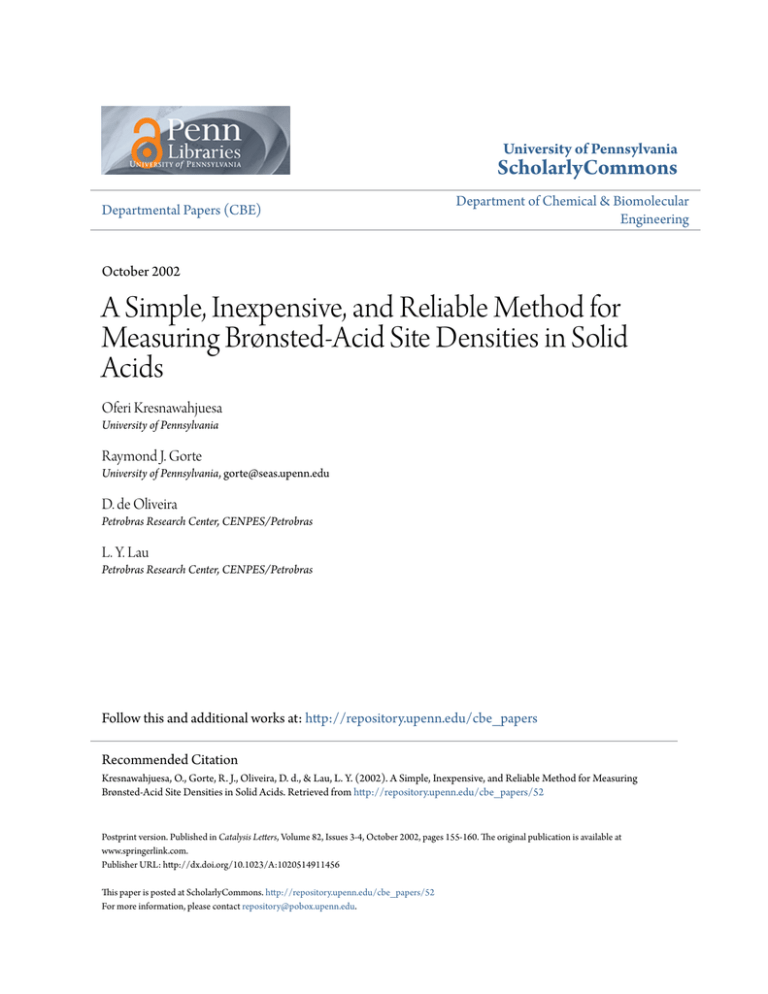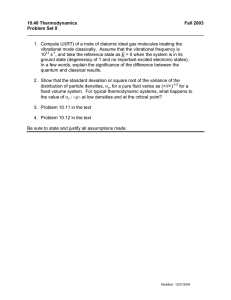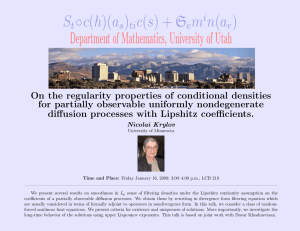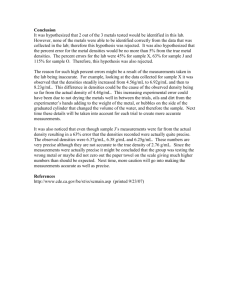A Simple, Inexpensive, and Reliable Method for Measuring Brønsted
advertisement

University of Pennsylvania ScholarlyCommons Departmental Papers (CBE) Department of Chemical & Biomolecular Engineering October 2002 A Simple, Inexpensive, and Reliable Method for Measuring Brønsted-Acid Site Densities in Solid Acids Oferi Kresnawahjuesa University of Pennsylvania Raymond J. Gorte University of Pennsylvania, gorte@seas.upenn.edu D. de Oliveira Petrobras Research Center, CENPES/Petrobras L. Y. Lau Petrobras Research Center, CENPES/Petrobras Follow this and additional works at: http://repository.upenn.edu/cbe_papers Recommended Citation Kresnawahjuesa, O., Gorte, R. J., Oliveira, D. d., & Lau, L. Y. (2002). A Simple, Inexpensive, and Reliable Method for Measuring Brønsted-Acid Site Densities in Solid Acids. Retrieved from http://repository.upenn.edu/cbe_papers/52 Postprint version. Published in Catalysis Letters, Volume 82, Issues 3-4, October 2002, pages 155-160. The original publication is available at www.springerlink.com. Publisher URL: http://dx.doi.org/10.1023/A:1020514911456 This paper is posted at ScholarlyCommons. http://repository.upenn.edu/cbe_papers/52 For more information, please contact repository@pobox.upenn.edu. A Simple, Inexpensive, and Reliable Method for Measuring Brønsted-Acid Site Densities in Solid Acids Abstract A method based on amine decomposition has been developed for measuring the Brønsted-acid site densities using a standard, tubular reactor with an on-line gas chromatograph (GC). After exposing a sample to npropylamine vapor and flushing it in flowing He at 473 K, the sample was ramped in flowing He to 773 K while trapping the products in the GC sample loop using liquid nitrogen. Site densities were determined from the quantity of propene formed by the decomposition of the n-propylammonium ions via the Hofmannelimination reaction. The use of small amounts of sample was shown to be important for elimination of secondary products. The method was tested using H-ZSM-5, H-FER, H-MOR, and H-Y zeolites, as well as a γ-Al2O3 sample, and shown to give essentially exact agreement with temperature-programmed-desorption (TPD) and thermogravimetric analysis (TGA) measurements of n-propylamine performed in vacuum. Keywords Brønsted acids, zeolites, alkyl amines, Hofmann-elimination reaction, temperature-programmed desorption Comments Postprint version. Published in Catalysis Letters, Volume 82, Issues 3-4, October 2002, pages 155-160. The original publication is available at www.springerlink.com. Publisher URL: http://dx.doi.org/10.1023/A:1020514911456 This journal article is available at ScholarlyCommons: http://repository.upenn.edu/cbe_papers/52 1 A Simple, Inexpensive, and Reliable Method for Measuring Bronsted-Acid Site Densities in Solid Acids O. Kresnawahjuesa and R. J. Gorte Department of Chemical Engineering University of Pennsylvania Philadelphia, PA 19104 USA and D. de Oliveira and L. Y. Lau Petrobras Research Center, CENPES/Petrobras , Ilha do Fundão, Cid. Universitária, Quadra 7, 21949-900, Rio de Janeiro, R.J., Brazil A method based on amine decomposition has been developed for measuring the Brønsted-acid site densities using a standard, tubular reactor with an on-line gas chromatograph (GC). After exposing a sample to n-propylamine vapor and flushing it in flowing He at 473 K, the sample was ramped in flowing He to 773 K while trapping the products in the GC sample loop using liquid nitrogen. Site densities were determined from the quantity of propene formed by the decomposition of the n-propylammonium ions via the Hofmann-elimination reaction. The use of small amounts of sample was shown to be important for elimination of secondary products. The method was tested using H-ZSM-5, H-FER, H-MOR, and H-Y zeolites, as well as a -Al2O3 sample, and shown to give essentially exact agreement with temperature-programmeddesorption (TPD) and thermogravimetric analysis (TGA) measurements of n-propylamine performed in vacuum. Keywords: Brønsted acids; Zeolites; Alkyl amines; Hofmann- elimination reaction; Temperature-programmed desorption. Running Title: Measuring Brønsted-Acid Site Densities. 2 INTRODUCTION The activity of solid-acid catalysts can depend on many factors, but the Brønsted-acid site density is usually one of the most crucial parameters. For example, it has been demonstrated that reaction rates for n-hexane cracking, xylene isomerization, propylene polymerization, the methanol-to-olefins reaction, toluene disproportionation, and cumene cracking all increase linearly with Al content in H-ZSM-5 [1-3]. Given that the Brønsted- acid site density is approximately equal to the framework Al concentration in H-ZSM-5, one can clearly infer a relationship between rate and site density. Even for much more complicated reaction systems, like the cracking of a gas oil over a commercial-type FCC catalyst, it has been shown that rates increase linearly with Brønsted-site densities [4]. A strong correlation has also been observed between rates and Brønsted-acid site densities on amorphous silica-alumina catalysts [5]. However, the measurement of Brønsted-acid site densities in solid acids is not trivial for many of the complex materials that are used industrially. Most oxides have hydroxyls and most of these are nonacidic; therefore, direct characterization of the Brønsted-acid sites by infrared or NMR spectroscopies requires that one be able to distinguish between the acidic and nonacidic hydroxyls. For example, the Brønsted sites in some zeolites can be distinguished by a welldefined stretching frequency, 3605 cm-1 in H-ZSM-5 [6] and 3640 and 3540 cm-1 in H-Y [7,8]; but overlapping features in the spectra often make it difficult to quantify the concentrations of these sites. This difficulty can be avoided by measuring the concentration of protonated bases in the solid. The most common application of this method is the characterization of pyridine adsorption by infrared spectroscopy [9]. Because the determination of extinction coefficients is difficult, IR of pyridine is usually used in a qualitative manner, rather than as a measurement of site densities. In another example of this methodology, 31P NMR of alkyl phosphines, probe molecules that have gas-phase basicities comparable to that of typical amines, can be used to measure the concentration of molecules protonated by Brønsted sites [10-12]. Determination of framework Al content by XRD lattice parameters [13] or 29Si NMR [14,15] is very useful and widely used to infer site densities. However, these techniques are primarily applicable only for zeolites with the FAU structure and they measure the site density only indirectly. Even when there are only protons present to balance the framework charge in HY, it should be recognized that a large fraction of sites are inaccessible to reactant molecules [16]. 27Al NMR is applicable to a wider range of zeolites but needs to be used with caution due 3 to the fact that both framework and non-framework Al can be tetrahedral [17,18]. Given that all aluminas have tetrahedral Al, this technique cannot be applied to amorphous catalysts. Temperature-programmed desorption (TPD) of ammonia may well be the most widely used method for characterization of site densities in solid acids due to the perceived simplicity of the technique. However, the actual interpretation of ammonia TPD results is far from simple and it has even been argued that the technique is not useful [19]. The major problem is that ammonia adsorption does not distinguish between Brønsted and Lewis sites. The best demonstration of this fact was given by Juskelis, et al [20], who showed that CaO is more acidic than a US-Y catalyst on the basis of ammonia TPD. It appears that ammonia associated with Lewis sites can be removed from high-silica zeolites by treating the samples with steam after ammonia adsorption [21]. It has yet to be demonstrated that this treatment can remove ammonia bound to Lewis sites on more complex solid acids, such as amorphous catalysts and H-Y zeolites that contain significant amounts of non-framework species. TPD of amines is a relatively new technique for measuring Brønsted-acid site concentrations [4-5,20-24]. The method is based on the fact that alkylammonium ions, formed when alkyl amines are protonated by Brønsted sites, decompose to ammonia and olefins in a well-defined temperature range via a reaction similar to the Hofmann-elimination reaction. So long as the alkyl group can give up a hydrogen atom to form an olefin and the amine is small enough to access the Brønsted sites, the measured site densities are independent of the particular amine used to probe the sites [25]. The technique is equally applicable to amorphous and crystalline solid acids. The adsorption and reaction can be described by Scheme I, as follows: HRNH2 + ZOH HRNH3+•••ZO- HRNH3+•••ZO- R + NH3 + ZOH Scheme I While the technique is conceptually simple, it requires a mass spectrometer to distinguish between NH3, olefins, and amines desorbing from the sample; and this instrumentation is unavailable in many industrial and catalysis laboratories. Because the decomposition temperature of the alkyl ammonium ions is the same for all Brønsted-acid sites so long as the sites are strong enough to protonate the amine, the only information that is used in the TPD measurements is the quantity of amines that react to ammonia and olefin products. This information can be readily obtained using a simple flow reactor and a gas chromatograph (GC), instrumentation that is available in almost every catalytic 4 laboratory. In this paper, we will provide experimental conditions that give reliable results, demonstrate the accuracy of those results for a wide range of solid acids, and discuss problems that the investigator could confront in the measurement of samples with unknown site concentrations. EXPERIMENTAL Measurement Procedures All of the samples investigated were first characterized using the TPD-TGA equipment described elsewhere [22]. In these experiments, approximately 20 mg of sample were spread over the sample pan of a Cahn microbalance mounted within a high-vacuum chamber. The system could be evacuated with a turbomolecular pump to a base pressure of ~10-7 Torr and the partial pressures could be determined using a quadrupole mass spectrometer. After heating the samples to 773 K in vacuum at 10 K/min to remove any impurities, they were cooled to room temperature, exposed to ~5 Torr of either n-propyl amine or isopropyl amine, and then evacuated for 1 hr. Finally, the sample temperature was ramped at 10 K/min to 773 K while monitoring desorption through the weight loss (microbalance) and the desorption products (mass spectrometer). In the new measurements, site densities were determined in two, essentially identical, flow reactors with on-line GCs, one at Penn and one at Petrobras. A schematic of the design is shown in Fig. 1. The reactors were simply quartz tubes; but all of the lines leading to and from the reactor were stainless steel, wrapped with heating tape, held at 350 K. After introducing each sample to a reactor, the temperature of the sample was ramped to 773 K at 20 K/min in flowing He (120 ml/min), then held at this temperature for 45 min. After cooling the sample to 373 K, it was exposed for 15 min to flowing He that had been saturated with n-propylamine at room temperature by flowing pure He through a bubbler containing the liquid amine. The sample was then heated to 473 K in flowing He for 90 min to remove excess n-propylamine and finally ramped to 773 K at 20 K/min. To collect the desorption products, the sample loop of the GC sampling valve was immersed in liquid nitrogen. This allowed the He carrier to pass through, but all other desorbing species were trapped. At the end of the reactor temperature ramp, the sample loop was isolated from the He flow, bypassing the sample loop with two, three-way values, as shown in the inset in Fig. 1. After warming the sample loop to room temperature to vaporize the collected products, 5 the six-way, GC valves were rotated to inject the collected products into the GCs, which in turn were equipped with flame-ionization detectors. (Notice that a single eight-way valve could have been used to isolate the sample loop from the He flow while the collected products vaporized, prior to injection, but that this could not be accomplished by the six-way valve alone.) In the case of the measurements at Penn, separation of the products was accomplished with a column provided by Alltech (Haysep Q® 80/100, 6’×1/8” S.S), while the chromatographic column at Petrobras was a Chromosorb 103®. Materials A complete list of the samples used in this study is shown in Table 1 along with their known properties. One sample, H-ZSM-5 with a Si/Al2 ratio of 55, was chosen to investigate the effect of sample size on the results. RESULTS AND DISCUSSION Fig. 2 shows the results from a TPD-TGA experiment with n-propyl amine on a highsilica zeolite, H-ZSM-5(55). If the Brønsted-acid site concentration for this sample were equal to the Al concentration, the site density would be 600 µmol/g. The TPD-TGA data show that desorption occurs in two, well-defined events, with un-reacted amine molecules (m/e = 30) desorbing below 500 K and only propene (m/e = 41) and ammonia (m/e = 17) desorbing between 650 and 725 K [26]. Based on the amount of n-propylamine that reacts to propene and ammonia, the site concentration on this sample is 500 µmol/g, lower than the Al concentration but very typical of what we observe on good quality H-ZSM-5 samples. We will not show data for other alkyl amines but the concentration determined using ethylamine and iso-propyl amine [19] was also 500 µmol/g. To test the use of a flow reactor to measure site densities, we studied this same sample, collecting ammonia and propene desorption products formed between 473 and 773 K. In the case of ammonia, we observed a great deal of scatter in the quantities of product detected between runs and amounts were sometimes twice the Brønsted-site density. We speculate that some of the ammonia may be forming by reaction of the amine on the heated stainless-steel tubing. When we did not heat the tubing walls, the “stickiness” of ammonia also made quantification of the collected products difficult. By contrast, the quantity of propene formed in the titration measurements was very reproducible; and, for small samples, the concentration of acid sites calculated from propene 6 formation agreed exactly with the high-vacuum TPD-TGA results. A problem encountered with the collection of propene was that large samples promote secondary oligomerization and cracking reactions. While the secondary products are easily observed in the titration measurements, their formation decreases the amount of propene collected. This is shown in Fig. 3, where we have plotted the amount of propene formed per mass of sample as a function of the sample mass, varying the sample mass from 20 mg to 200 mg. The figure shows that secondary chemistry becomes a problem for sample sizes greater than 50 mg, corresponding to 40 µmol of acid sites. In principle, the secondary chemistry is not a problem. It should be possible to determine the total amount of carbon leaving the sample in all products and then calculate the amount of amine that had reacted based on the carbon balance so long as all carbon-containing products leave the sample; however, this would require calibrating the GC for all possible products. Furthermore, the very high sensitivity of the flame ionization detector provides plenty of signal for samples even smaller than 20 mg, making it unnecessary to use larger samples. Finally, we used the flow systems with liquid-nitrogen trapping to determine the Brønsted-acid site densities of a wide range of solid acids that had been characterized previously, with the results reported in Table 2. We used between 20 and 30 mg of sample in all of the experiments. Data from TPD-TGA measurements carried out in ultra-high vacuum on these same samples are also shown for comparison. The data demonstrate several important observations. First, the agreement between the TPD-TGA measurements and the flow-reactor measurements is excellent for samples with site densities ranging from more than 1000 µmol/g to less than 5 µmol/g. Indeed, the differences between the site densities determined using the two methods are so small that they may well be due to inaccuracies in the measurement of the sample weight. Second, for each of the high-silica zeolites other than H-Y(71), the site densities are in reasonable agreement with the framework Al concentrations. It has been known for many years that very high Al concentrations can lead to lower catalytic activities [27], so that it is uncertain what site densities should be expected for those materials; but one should expect reasonable agreement between framework Al concentration and Brønsted site densities for the high-silica materials. Third, the flow-reactor TPD measurements are sensitive only to Brønsted sites. No Brønsted sites were detected on the -Al2O3 sample, which is known to have Lewis acid sites but not Brønsted sites [5]. Because of the strong Lewis acidity of -Al2O3, characterization of materials that contain alumina represents 7 a special challenge to avoid over counting sites, but the amine decomposition reaction is not sensitive to the Lewis sites. Fourth, good agreement is observed in the measured site densities for zeolites having the MFI, MOR, FER, and FAU structures, demonstrating the utility of the technique for the characterization of molecular sieves with small, medium and large pore sizes. The results for the H-Y zeolites deserve additional comment. The high silica-alumina ratios of these samples were achieved by steaming a parent material, then removing some of the alumina through acid leaching. For all of these samples, the framework Al content was much lower than the bulk Al contents reported here [24]. More important, even the framework Al contents of H-Y zeolites are significantly higher than the Brønsted site densities due to the fact that only a fraction of the protonic sites in H-Y zeolites are able to protonate strong bases [24]. It has been shown that only the hydroxyl groups associated with a band at 3640 cm-1 are able to form pyridinium ions and alkyl ammonium ions upon adsorption of strong bases like pyridine and isopropyl amine, while the hydroxyl groups associated with a band at 3540 cm-1 are not [24]. Therefore, the low site concentrations of these materials likely reflects the fact that many of the sites in H-Y zeolites are inaccessible for adsorption. We have chosen to use n-propylamine for characterization of the sites in this study, but the reader should recognize that other amines would provide similar information [25,26]. We chose n-propylamine over iso-propylamine because it reacts to propene and ammonia at a temperature that is 50 K higher, which allows a better separation between the physically adsorbed amines and the molecules protonated by the acid sites. If physically adsorbed amines remain on the sample up to the point at which the Hofmann elimination begins, there is the possibility for readsorption of amine molecules onto empty sites, which would result in over counting of the sites. n-Propylamine was chosen over larger amines because the olefins formed by larger amines would tend to be more reactive and prone to secondary chemistry. Ethylamine may have been a better choice due to the lower reactivity of ethene compared to propene in acidic zeolites [28]. Ethylamine decomposes at exactly the same temperature as n-propylamine and should provide similar information, but we did not investigate this possibility. We have also tried to show that this technique is quite general in that it can be used to characterize simple, high-silica zeolites like H-ZSM-5 and more complex materials like alumina or a US-Y zeolite. We did not attempt to look at solid acids that have redox properties, such as sulfated zirconias [29], or materials which might be unstable in He at 773 K. Obviously, the 8 characterization of these materials will represent special challenges to any technique that is used to characterize them. CONCLUSIONS We have demonstrated that Brønsted-acid site densities can be accurately determined on a wide range of typical solid acids using a simple, tubular flow reactor with an on-line gas chromatograph. By trapping the products formed when protonated amines decompose via the Hofmann-elimination reaction, the site densities can be easily calculated from the quantities of olefins produced. ACKNOWLEDGEMENT The authors gratefully acknowledge the financial support from ACS-PRF, through Grant #36615-AC, and assistance in data collection from J. Elsabee. REFERENCES 1. W.O. Haag, Stud. Surf. Sci. Catal., 84 (1994) 1375. 2. D.H. Olson, W.O. Haag, R.M. Lago, J. Catal., 61 (1980) 390 3. W.O. Haag, N.Y.Chen, Catalysis Design: Progress and Prospectives, L.L.Hegedus, Ed., Wiley, New York (1987) 181 4. A.I. Biaglow, C. Gittleman, R.J. Gorte, R.J. Madon, J. Catal., 129 (1991) 88 5. J. Tittensor, R.J. Gorte, D. Chapman, J. Catal., 138 (1992) 714 6. P.A. Jacobs, R. von Ballmoos, J. Phys. Chem., 86 (1982) 3050 7. J.W. Ward, R.C. Hansford, J. Catal., 13 (1969) 364 8. C.L. Angell, P.C. Schaffer, J. Phys. Chem., 69 (1965) 3463 9. E.P. Parry, J. Catal., 2 (1963) 371 10. H.M. Kao, H.M. Liu, J.C. Jiang, S.H. Lin, C.P. Grey, J. Phys. Chem. B, 104 (2000) 4923 11. E.F. Rakiewicz, A.W. Peters, R. Wormsbecher, K.J. Sutovich, K.T. Mueller, J. Phys. Chem. B, 102 (1998) 2890 12. A. Bendada, E.F. Derose, J.J. Fripiat, J. Phys. Chem., 98 (1994) 3838 13. D.M. Bibby, L.P. Aldridge, N.B. Milestone, J. Catal., 72 (1981) 373 14. J.M. Thomas, S. Ramdas, G.R. Millward, J. Klinowski, M. Audier, J. Gonzales-Calbet, C.A. Fyfe, J. Solid-State Chem., 45 (1982) 368 15. J. Klinowski, S. Ramdas, J.M. Thomas, C.A. Fyfe, J.S. Hartman, J. Chem. Soc, Faraday Trans. 1, 78 (1982) 1025 9 16. A.I. Biaglow, D.J. Parrillo, R.J. Gorte, J. Catal., 144 (1993) 193 17. Z. Luz, A.J. Vega, J. Phys. Chem., 91 (1987) 374 18. J. Klinowski, Progress in NMR Spectroscopy, 16 (1984) 237 19. R.J. Gorte, Catal. Lett., 62 (1999) 1 20. M.V. Juskelis, J.P. Slanga, T.G. Roberi, A.W. Peters, J. Catal., 138 (1992) 391 21. J.L. Woolery, G.H. Kuehl, H.C. Timken, A.W. Chester, J.C. Vartuli, Zeolites, 19 (1997) 288 22. T.J. Gricus Kofke, R.J. Gorte, W.E. Farneth, J. Catal., 114 (1988) 34 23. T.J. Gricus Kofke, R.J. Gorte, G.T. Kokotailo, W.E. Farneth, J. Catal., 115 (1989) 265 24. A.I. Biaglow, D.J. Parrillo, G.T. Kokotailo, R.J. Gorte, J. Catal., 148 (1994) 213 25. D.J. Parrillo, A.T. Adamo, G.T. Kokotailo, R.J. Gorte, Appl. Catal. A, 67 (1990) 107 26. C. Pereira, R.J. Gorte, Applied Catalysis A, 90 (1992) 145 27. J.R. Sohn, S.J. Decanio, P.O. Fritz, J.H. Lunsford, J. Phys. Chem, 90 (1988) 4847 28. T.J. Gricus Kofke, R.J. Gorte, Journal of Catalysis, 115 (1989) 233 29. D.R. Milburn, K. Saito, R.A. Keogh, B.H. Davis, Appl. Catal. A, 215 (2001) 191 Figure Captions 1) A schematic of the experimental apparati used in making the acid site-density measurements. 2) TPD-TGA results for n-propylamine desorption from H-ZSM-5(55). 3) The quantity of propene formed per sample mass for the H-ZSM-5(55) sample in TPD measurements with n-propylamine performed with the flow-reactor system. For larger samples, secondary reactions decreased the amount of propene observed. 10 Table 1. Sample Information Sample Origin H-ZSM-5(55) NIST 2852 H-MOR(79) H-MOR(19.7) As synthesized; prepared at Penn [23]. Conteka CBV 20A H-FER(55) Zeolyst CP 914 H-Y(7) PQ 1169-5602 H-Y(9.6) PQ 1169-5603 H-Y(30) PQ 1169-5605 H-Y(71) PQ 1169-5608 -Al2O3 Alfa AESAR Si/Al2 (Bulk) (µ µmol/g) 55 [606] 79 [421] 19.7 [1690] 55 [606] 7 [4757] 9.6 [3469] 30 [1110] 71 [469] - Table 2. Summary of the Acid Sites Measured by Different Techniques Sample H-ZSM-5(55) H-MOR(71) H-MOR(19.7) H-FER(55) H-Y(7) H-Y(9.6) H-Y(30) H-Y(71) -Al2O3 (1) (2) (3) (4) TPD-TGA of n-propylamine Brønsted-site conc. (µmol/g) 500 395(1) 1000 350 850(2) 440(2) 130(2) 68(2) <5(3) GC trapping experiment(4) Brønsted-site conc. (µmol/g) 500 (4645) 390 1044 (9175) 379 850 415 160 62 <5 Based on TPD-TGA of n-propylamine [23]. Based on TPD-TGA of iso-propyl amine [24] Based on TPD-TGA of iso-propyl amine [5]. Results obtained using n-propylamine. Brønsted-site concentration is measured based on the amount of propene collected. The sample sizes varied between 20 and 30 mg. (5) These values were obtained at Petrobras.







